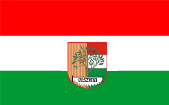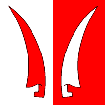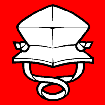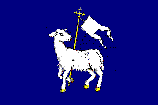- ABASED
- (adv) A heraldic term for when the main ordinary on a shield, banner of
arms or flag is placed in a lower position than is usual - lowered (see also
enhanced and
ordinary).
![[abased example]](../images/v/vxt-d006.gif)
![[abased example]](../images/v/vxt-d006a.gif)
![[abased example]](../images/v/vxt-d006b.gif)
![[abased example]](../images/v/vxt-d006c.gif)

From left: Examples (4); Flag of Olszyna, Poland (Jarig Bakker)
- ABEYANCE
- See in abeyance.
- ABSENCE (or ABSENTEE) PENNANT (or FLAG)
- 1) In widespread naval usage, one of four pennants (the first to the fourth
substitute in the NATO Code of Signals) displayed in port when the commanding officer of a ship
or the flag officer or civil official whose flag is flying in the ship is temporarily
absent from the vessel (see also
'international code of signal flags and
international code of signals).
- 2) See owner absent flag.
![[absence example]](../images/v/vxt-d008.gif)
From left: First Substitute (Flag Officer Absent),
Second Substitute (Chief of Staff Absent), Third Substitute (Captain Absent),
Fourth Substitute (Civil/Military Official Absent)
- ACCOLΙ
- See gorged.
- ACCRETION
- A term sometimes used by textile experts involved in fabric conservation,
and describes the soiling, mildew damage or other defects that occur on the surface
of a flag.
- ACHIEVEMENT (OF ARMS)
- 1) See armorial bearings.
- 2) All the armorial bearings of a deceased person as displayed at that persons
funeral a funeral achievement or hatchment (see also armorial bearings,
badge banner,
bannerole,
coat of arms,
great banner
and grumphion).
Please note with regard to 2) that if all
the armorial bearings of a deceased person are displayed on a flag they become
a great banner, or if less than all a bannerole, both as referenced above.
- ACTION PENNANT
- See paying off pennant.
- ACTIVE
- A term used to describe when the rays of a star or sun emblem, or a radiating
stripe, are shown with undulating or wavy curves see
active and inactive below,
inactive
(also radiating,
star
and its following note,
sunburst and
wavy).
- ACTIVE AND INACTIVE
- In vexillology a term that may be used to describe when the rays of a star or sun
emblem are shown with alternating wavy and straight rays but see
sun-in-splendour
(also
active above,
inactive,
star and its following note,
sunburst and
wavy).
![[Active/Inactive example]](../images/v/vxt-d564.gif)
![[absence example]](../images/v/vxt-d564a.gif)
The Sun and Star of May, Argentina and Uruguay (fotw)
- ADDITION(S) OF HONOUR (or HONOR)
- See augmentation of honour.
- ADDORNED
- See garnished.
- ADDORSED
- 1) See appendix V.
- 2) The heraldic term also used when two charges are turned outwards -
endorsed (see also
charge 1)).




Flag and Arms of Turosn, Poland (Jarig Bakker); Flag of Sugnens, Switzerland (fotw); Flag of Dorneck, Switzerland (fotw)
- ADVANCE THE COLOUR/COLOURS (or COLOR/COLORS)
- (v) A military term originally for moving a flag forward towards an enemy,
and now used on ceremonial occasions as a command to parade the colour(s) forward
(see also colour 2),
colours 2), and
parade flag).
- ADVERTISING BANNER
- See banner 4).
![[advertising banner]](../images/v/vxt-d577.gif)
- ADVERTISING PULLDOWN (or PULL-DOWN)
- See pulldown.
- AFFRONTANT (or AFFRONTΙ)
- See respectant in appendix V.
- AFFRONTY
- 1) See appendix V.
- 2) The heraldic term also used when a charge, such as a helmet, house or ship, is shown with
its front towards the observer.


Flag of Hersberg, Switzerland (fotw); Flag of Oberφnz, Switzerland
With regard to 1) please note this term is not to be confused with affrontant
see respectant and its following note in appendix V.
- AGNUS DEI
- The Latin term for a lamb that is sometimes shown with a halo around its head, but always holding
a crossed staff or crosier (and often decorated with a flag or banner) the Holy Lamb or Lamb of God.






Flag of Kunovice, Czech Republic (fotw); Flag of Gotland, Sweden (fotw);
Flag and Arms of Preston, UK (fotw); Arms and Flag of Knin, Croatia (fotw)
- AIR FORCE (or AIRFORCE) FLAG (or ENSIGN)
- See branch of service flag
(also armed services flag and
ensign 2)).

Air force Ensign, UK (fotw).
- AIR MAIL (or AIRMAIL) FLAG (or PENNANT)
- A flag or pennant, now obsolete, originally designed to fly (sometimes alongside a civil air ensign)
from an aircraft carrying mail (see also postal flag and
civil air ensign)

 US Air mail Flag (Joe Macmillan); Royal Air Mail Pennant, UK (fotw)
US Air mail Flag (Joe Macmillan); Royal Air Mail Pennant, UK (fotw)
- AIRCRAFT INSIGNIA
- In US military usage, the term that refers to markings on the tail plane/fin of
primarily (but not exclusively) military aircraft see fin flash
(also aircraft marking(s) below and
roundel 1)).
- AIRCRAFT MARKING(S)
- In UK and some other usage, a collective term for the markings of nationality and identification on the wings,
fuselage and tail plane/fin of primarily (but not exclusively) military aircraft but see
fin flash
and roundel 1) (also
aircraft insignia above).
- AIRFIELD (or AIRPORT) SAFETY (or AIRFIELD/AIRPORT CONSTRUCTION) FLAG
- In largely US usage the square, orange and white-checkered safety flag mandated by the
US Federal Aviation Administration for the marking of construction vehicles and jobsite
obstructions/hazards at airports. (see also checky).

- ALFAQUAQUUS
- The medieval term, now obsolete, for a person who is entitled to carry his
banner erect on the Kings highway.
This word is recorded as having a Spanish origin (which
remains unproven) however, the extent to which it was used in English medieval
manuscripts is not known.
- ALFERES (or ALFEROUS)
- A late 17th early 18th Century term, now obsolete, for a
standard bearer.
Please note, it is suggested that the alternative form was sometimes used in
medieval manuscripts, and note also the relationship between this term and the
Spanish military rank of alfιrez or ensign (see also
ensign 5).
- ALLEGORY (or ALLEGORICAL)
- The term for a pictorial illustration with a symbolic meaning, and
whose imagery is usually intended to convey a moral and/or political message.



Flag of the State of Virginia, US (fotw); Jack and
Command Flag of the Batavian Republic 1797, The Netherland (fotw)
- ALLUSIVE ARMS
- See canting.
- ALQUILIFER
- A bearer of the ancient Roman legionary eagle - see
'eagle 2)'
(also 'vexillary' and
'vexilloid').
- ALTEMA
- A medieval term, now obsolete, for the upper part of the cart upon which the
standard was placed (see also carrocium,
gajardus and standard 6)).
- ALTERNATIVE (or ALTERNATE) FLAG/ENSIGN
- The term used to describe any flag or ensign (either official or unofficial) being presented
as an alternative to that which is generally accepted (or officially established) for a particular role.


National Flag/Civil Ensign as regulated, and Alternative Civil Ensign of the United Arab Emirates (fotw)
- AMBASSADORIAL (or AMBASSADORS) FLAG
- See diplomatic flags.
- AMERICAN WAR MOTHERS FLAG
- See service flag 3).
- ANCIENT
- 1) In heraldry, a coat of arms or charge formerly in use but now replaced
by another design which is then termed modern such as, for example, Austria ancient
and Austria modern.
- 2) A 16th/17th Century term, now wholly obsolete, for a ships stern mounted
ensign, or military colour whether displayed ashore or afloat - an anshent or auncient (see also
ensign 1) and
colour 2)).
- 3) A 16th/17th Century term, now wholly obsolete, equivalent to, and with
the same duties as, the later but also obsolete army rank of ensign (see also
ensign 3) and
ensign 4)).
![[ancient example]](../images/v/vxt-d012.gif)
From left: Austria Ancient, Austria Modern (fotw)
- ANCIENT CROWN
- See antique crown 1) and
coronet 1).
- ANNULET
- A ring-like charge in heraldry see ring.

Flag of Samtgemeinde Velpke, Germany (Jφrg Majewski)
Please note however, it is suggested that a suitable
glossary or dictionary of heraldry be consulted for correct usage of this term.
- ANSHENT
- See ancient 2).
- ANTESIGNORY (or ANTESIGNANUS)
- A term, now obsolete, for the guard who precedes a standard (see also
standard 5)).
Please note, it is suggested that the alternative form was
used in medieval manuscripts.
- ANTI-ALIASING
- A computer graphics term used to describe the technique of giving low resolution flag
illustrations a smoother appearance by colouring pixels at the border between two differently
coloured surfaces with intermediate shades.
- ANTI-HERALDRY (or ANTIHERALDRY)
- A term used to describe the design of those seals and emblems which do not contain
(and may have been specifically designed not to contain) heraldic symbolism for example
the seals of many US states widely used on their flags which are (and were) prepared in
the absence of any central heraldic authority (see also
heraldry,
emblem 2),
pre-heraldic,
seal,
seal flag and
state flag 2)).

State Seal of Virginia, US (ICH)
Please note, it is suggested that the origins of any such rejection of heraldic
symbolism may be traced to the American War of Independence and French Revolution,
and to the consequent official reaction against all things connected with royalty and
the nobility.
- ANTIQUE CROWN
- 1) Generically and in Continental European heraldry see coronet).
- 2) Specifically in English heraldry, a type of coronet that is generally (but not exclusively) composed
of a circlet with triangular rays all round.
![[antique crown]](../images/v/vxt-d014.gif)
An English Pattern Antique Crown (Parker)
- ANTLER(S)
- See attire(s).
- ANTLERED
- See attired.
- APPLIQUΙ
- (n & v) A method of flag manufacture in which one or more pieces of cloth
are stitched on the field to form a design. This technique is often used where
the design on the obverse differs from that on the reverse (see also
obverse
and reverse).
- APPOINTMENT FLAG
- 1) In UK and other military usage, that flag which corresponds to a particular
position held, rather than to the rank of the officer who currently holds it -
but see positional flag
(also class flag and rank flag 1)).
- 2) See distinguishing flag 1).
![[appointment flag example]](../images/v/vxt-d016.gif)
RAF Station Commander, UK (Graham Bartram)
![[abased example]](../images/v/vxt-d006.gif)
![[abased example]](../images/v/vxt-d006a.gif)
![[abased example]](../images/v/vxt-d006b.gif)
![[abased example]](../images/v/vxt-d006c.gif)

![[absence example]](../images/v/vxt-d008.gif)
![[Active/Inactive example]](../images/v/vxt-d564.gif)
![[absence example]](../images/v/vxt-d564a.gif)













 US Air mail Flag (Joe Macmillan); Royal Air Mail Pennant, UK (fotw)
US Air mail Flag (Joe Macmillan); Royal Air Mail Pennant, UK (fotw)






![[antique crown]](../images/v/vxt-d014.gif)

![[advertising banner]](../images/v/vxt-d577.gif)


![[ancient example]](../images/v/vxt-d012.gif)
![[appointment flag example]](../images/v/vxt-d016.gif)